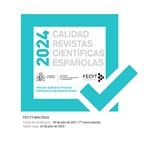Representación territorial y régimen electoral para Cuba bajo la vigencia de las Constituciones de 1869 y 1876. (RI §418246)

Territorial representation and electoral system for Cuba under the spanish Constitutions of 1869 and 1876 -
José Joaquín Fernández Alles
Este artículo describe y analiza el régimen jurídico de los tres métodos de representación (Cortes Generales, representación local y Parlamento bicameral autonómico) que vivió la isla de Cuba desde 1869 hasta 1898 conforme a una regulación constitucional (1869 y 1876) y legal que, empleando la vía de la deslegalización, encomendó a la potestad reglamentaria el tratamiento de cuestiones teóricas del Estado que, como había ocurrido las Cortes de Cádiz, necesitaban ser tratadas en la sede parlamentaria. En virtud de esta abdicación del debate doctrinal por parte de las Cortes Constituyentes y de las Cortes Generales, que provocó incluso que el Consejo de Ministros debiera tramitar parlamentariamente sendas autorizaciones de exención de responsa-bilidad, en el proceso de independencia de la provincia de Cuba subyace un incumplimiento de las funciones constitucionales de la representación nacional.
I. CUBA EN LA HISTORIA CONSTITUCIONAL ESPAÑOLA: LA REPRESENTACIÓN PARLAMENTARIA. II. LA REPRESENTACIÓN PARLAMENTARIA EN LAS CORTES GENERALES: EL RÉGIMEN ELECTORAL PARTICULAR PARA CUBA. 1. El Decreto de 14 de diciembre de 1868. 2. La Ley provisional de 20 de julio de 1876. 3. Los Reales Decretos de 1878. III. LA REPRESENTACIÓN TERRITORIAL: DESDE EL RÉGIMEN LOCAL CUBANO AL PARLAMENTO BICAMERAL AUTONÓMICO. 1. La Ley Orgánica de 21 de junio de 1878 y el Decreto de 1 de marzo de 1878: la democracia representativa en Cuba. 2. El Real Decreto de 23 de julio de 1878. 3. La fase final descentralizadora (1893-1898) y el Parlamento bicameral autonómico. IV. A MODO DE CONCLUSIONES: UNAS CORTES GENERALES SIN TEORÍA DEL ESTADO PARA LAS PROVINCIAS DE ULTRAMAR. V. BIBLIOGRAFÍA.
This article describes and analyzes the legal regimen of the three methods of representation (Parliament, local representation in provinces and municipalities, and autonomic bicameral parliament) that was organized in Cuba during period 1869-1898. According to a constitutional regulation (1869 and 1876) and a politcical practice that abused the delegalization technique and indemnity bills. The Parliament assigned to the Government the treatment and debate about theory of the State. Unlike the Cortes of Cádiz, there was a real abdication of this doctrinal debate by the constituent power and the Parliament. And for this reason, in the independece process of Cuba, underlies a breach of the constitutional functions by national representation.
I. CUBA IN THE SPANISH CONSTITUTIONAL HISTORY: THE PARLIAMENTARY REPRESENTATION. II. PARLIAMENTARY REPRESENTATION IN THE CORTES GENERALES: THE PARTICULAR ELECTORAL REGIMEN FOR CUBA. 1. Decree of December 14, 1868. 2. The Provisional Law of July 20, 1876. 3. The Royal Decrees of 1878. III. TERRITORIAL REPRESEN-TATION: SINCE CUBAN LOCAL REGIME TO AUTONOMIC BICAMERAL. 1. The Organic Law of June 21, 1878 and the Decree of March 1, 1878: the representative democracy in Cuba. 2. The Royal Decree of July 23, 1878. 3. The decentralization final phase (1893-1898) and the autonomic bicameral Parliament. IV. CONCLUSIONS: A CORTES GENERALES WITHOUT THEORY OF STATE FOR THE PROVINCES OF OVERSEAS. V. BIBLIOGRAPHY.

 DIRECTORA
DIRECTORA